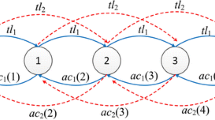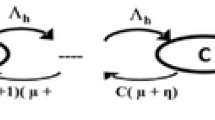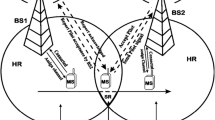Abstract
In code division multiple access mobile cellular networks, the transmission quality can be improved by using the soft handoff techniques. The present investigation is concerned with the admission control policies by exploiting the soft handoff coverage area of the cellular radio network. We suggest finite Markov models for the admission control based on reserve channel and sub-rating policies. In reserve channel policy, a fixed number of channels are reserved exclusively to serve the handoff calls whereas according to sub-rating policy, the occupied channels can be split into two half rate channels to accommodate more handoff voice calls. It is also considered that the new call generation rate per unit area is uniformly distributed over the service area. Various performance indices are derived in terms of steady state probabilities. For some special situations, we validate and compare the models developed with previous existing models by setting the system descriptors. To examine the effect of various parameters on the performance measures, the sensitivity analysis is carried out by taking illustrations.















Similar content being viewed by others
References
M. H. Ahmed and S. A. Mahmoud, QoS based admission and load control algorithm for integrated voice/data services over wideband CDMA, Wireless Personal Communications, Vol. 23, pp. 11–29, 2003.
Gowri. S. S. Anupama and B. P. Rao, A survey of soft handoff prioritization schemes in CDMA cellular networks, International Journal of Engineering Science and Technology, Vol. 3, No. 4, pp. 2811–2824, 2011.
D. Avidor, N. Hegde and S. Mukherjee, On the impact of the soft handoff threshold and maximum size of the active group on resource allocation and outage probability in the UTMS system, IEEE Transactions on Wireless Communications, Vol. 3, pp. 565–577, 2004.
M. Cho, K. Park, D. Son and K. Cho, Effect of soft handoffs on channel resource in DS-CDMA mobile systems, IEEE Transactions on Communications, Vol. E-85, No. B, pp. 1499–1510, 2002.
K. C. Chu, L. P. Hung and F. Y. S. Lin, Adaptive channel reservation for call admission control to support prioritized soft handoff in a cellular CDMA system, Annals of Telecommunications, Vol. 64, pp. 777–791, 2009.
S. Ghosh and A. Konar, Call Admission Control in Mobile Cellular Network437 ed., Series of Studies in Computational Intelligence. SpringerBerlin, 2013.
S. C. Ghosh, R. M. Whitaker, S. M. Allen and S. Hurley, Optimising CDMA cell planning with soft handover, Wireless Personal Communications, Vol. 68, No. 2, pp. 321–347, 2013.
R. A. Guerin, Channel occupancy time distribution in a cellular radio system, IEEE Transactions on Vehicular Technology, Vol. VT-35, pp. 89–99, 1987.
M. Jain and R. Mittal, Performance analysis in double layer cellular network with new call bounding scheme and directed retry, CSI: Computer Society of Iran, Journal of Computer Science and Engineering, Vol. 9, No. 2, pp. 1–10, 2014.
M. Jain and Rakhee, Priority based channel allocation schemes for PCS with integrated traffic. Emerging Convergent Technologies and Systems (SECATS), Allied Publishers Ltd., New Delhi, (Ed. S. B. Rao), pp. 79–84, 2002.
M. Jain, G. C. Sharma and R. Mittal, Transient analysis of channel allocation in cellular radio network with balking and reneging, CSI Computer Society of India, Vol. 38, No. 4, pp. 11–19, 2008.
M. Jain, G. C. Sharma and R. Mittal, Performance analysis of a prioritized call admission control schemes for integrated traffic in wireless network, International Journal of Electronics Communication and Computer Engineering, Vol. 4, No. 1, pp. 283–291, 2013.
M. Jain, G. C. Sharma, and R. Mittal, Queueing analysis and channel assignment scheme for cellular radio system with GPRS services, International Journal of Mathematics in Operational Research, Vol. 6, No. 6, pp. 704–731, 2014.
J. Khan, Handover management in GSM cellular system, International Journal of Computers and Applications, Vol. 8, No. 12, pp. 14–24, 2010.
D. K. Kim and D. K. Sung, Traffic management in a multicode CDMA system supporting soft handoffs, IEEE Transactions on Vehicular Technology, Vol. 51, pp. 52–62, 2002.
X. Ma, Y. Liu and K. S. Trivedi, Design and performance analysis of a new soft handoff scheme for CDMA cellular systems, IEEE Transactions on Vehicular Technology, Vol. 55, No. 5, pp. 1603–1612, 2006.
S. S. Rappaport, Models for Call Handoff Schemes in Cellular Communication Networks, Third Generation Wireless Information Networks, Kluwer Academic Publisher Norwell, 1992. pp. 163–185.
S. D. Roy and S. Kundu, Performance analysis of cellular CDMA in presence of beam forming and soft handoff, Progress in Electromagnetic Research (PIER), Vol. 88, pp. 73–89, 2008.
V. K. Saini and S. C. Gupta, Improving capacity of soft handoff performance in wireless mobile communication using macro diversity, International Journal of Computational Science and Engineering, Vol. 3, No. 6, pp. 2217–2223, 2011.
M. Salamah and H. Lababidi, Dynamically adaptive channel reservation scheme for cellular network, Computer Networks, Vol. 49, No. 6, pp. 787–796, 2005.
A. Sgora and D. Vergados, Handoff prioritization and decision scheme in wireless cellular network: a survey, IEEE Communications Surveys & Tutorials, Vol. 11, No. 4, pp. 57–77, 2009.
T. L. Sheu and T. L. Hou, An analytical model of cell coverage for soft handoffs in cellular CDMA systems, GESTS International Transactions on Computer Science and Engineering, Vol. 18, No. 1, pp. 209–223, 2005.
T. L. Sheu and T. L. Hou, On the influences of enlarging or shrinking the soft handoff coverage for a cellular CDMA system, Journal of Information Science and Engineering, Vol. 23, pp. 1453–1467, 2007.
S. Tamilselva and K. Manivannan, Optimization of soft handoff margin in WCDMA cellular system, International Journal of Communication Networks and Distributed Systems, Vol. 4, No. 3, pp. 254–264, 2010.
R. Thomas, H. Gibert, and G. Mazziotto, Influence of the movement of mobile station on the performance of a radio cellular network. In: Proceedings of 3rd Nordic Seminar, Copenhagen, Denmark, pp. 94–106, 1988.
V. V. Veeravalli and A. Sendonaris, The coverage-capacity trade-off in cellular CDMA systems, IEEE Transactions on Vehicular Technology, Vol. 48, No. 5, pp. 1443–1450, 1999.
J. Zhang, J. W. Mark and X. Shen, An adaptive resource reservation strategy for handoff in wireless CDMA cellular networks, Canadian Journal of Electrical and Computer Engineering, Vol. 29, No. 1, pp. 77–83, 2007.
Acknowledgments
We are thankful to Professor G. C. Sharma, Dr. B. R. A. University, Agra for his advice and to the Chief Editor and learned reviewers for their valuable suggestions and comments for the improvement of the paper.
Author information
Authors and Affiliations
Corresponding author
Appendix 1
Appendix 1
1.1 Product type solution
Using the appropriate transition rate and with the help of the state transition diagram i.e. Fig. 3, the following set of equations is constructed.
Equation (30) can be written as
Solving Eqs. (31) and (32) recursively, we obtain product type result given in Eq. (15) for the interval \(1 \le j \le C - r\).
Similarly, on solving Eqs. (33) and (34) recursively, we get the product type result as given in Eq. (15) for the range \(C - r + 1 \le j \le C\).
Now, on applying the normalizing condition i.e. \(\sum\nolimits_{j = 0}^{C} {P_{j} = 1}\), we obtain Eq. (16).
Rights and permissions
About this article
Cite this article
Jain, M., Mittal, R. Call Admission Control for Soft Handoff Coverage in CDMA Cellular System. Int J Wireless Inf Networks 22, 53–66 (2015). https://doi.org/10.1007/s10776-014-0255-7
Received:
Accepted:
Published:
Issue Date:
DOI: https://doi.org/10.1007/s10776-014-0255-7




